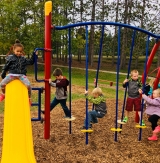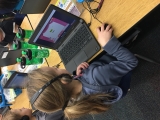-
Category 1
Selected in 2019
-
Grades: k - 5
School Setting: rural
Town Population: 858
Student Enrollment: 153
Student Demographics:
Black/African American: 2%
Teacher/Student Ratio: 1:18
White/Caucasian: 96%
Hispanic: 2%
Hawaiian/Pacific Islander: 0%
Asian: 0%
Native American: 0%
Other: 0%
% Reduced Lunch: 77%
% ELL Learners: 0%
Founded: 1935 -
PRINCIPAL:
Chris Arrington -
CONTACT:
510 West Main Street
Marion, MI 49665
231-743-2486
carrington@marion.k12.mi.us
Marion Elementary School
Marion, MI
We focus on empowering our students to care about their academic performance.
- Describe specific programs in place to ensure that families are involved in the success of your school and students.
-
Our school offers four Family Engagement Nights per year. Honestly, they are centered around "family fun." Games, activities, prizes, and any other seasonal/topical gimmick is fair play. In our small, rural, and disenfranchised community, these nights are a big hit, and well-attended, including extended family members. Truth be told, the goal for these evenings are not to "trap" families into talks of academics. The goal is to provide the school as a provider of fun and entertainment for our families and kids. The goal is to build this "no strings attached" rapport, in the hopes when individual conferences, phone calls, IEP's,
etc., do take place, we have built the relationship and trust of our adult partners. Our staff has determined when it comes to parent/guardian relations, we must "go slow in order to go fast." - Describe the most successful activity your school has initiated to strengthen ties to your community.
- We offer highly engaging parent/family nights four times per year. We are working with our Village to have a parade through our town and local community.
- Describe your philosophy of school change or improvement.
- We believe deeply in the scripted process our state's guided process. That said, we have learned to inherently trust our collective common sense to: 1) Identify issues, both data and perception driven; 2) Discuss and collaboratively plan to combat the issue(s); 3) determine mechanisms to progress monitor and "summative evaluate" our efforts, and; 4) Never give up. We can't influence certain things in the lives of our students. We can greatly influence the sphere in which we have direct contact with our students. We know this is our greatest avenue for improvement and success.
- What are your school’s top two goals for the next year?
-
We would love to list a litany of pure academic and student performance goals here. While our staff is equipped to load up on the training, expertise, and focus to achieve just this, we realize we will get further/faster by giving our collective attention to the following:
1) We need to focus on student enrollment. We will not to pretend to
know how other states fund their schools, but for us, in Michigan,
we are funded per pupil. We are down to 400 students K-12. We
predicted to be financially extinct in the next two school years. How
can we provide the excellent education we deliver if we are out of
business? Our state is a "School of Choice" state, and we have lost
586 students ($5.3 Million in State funding) in the last ten years.
2) In our small community, the elementary has always been known as
the "good school." Parents leave after fifth grade. How do we
continue our success while helping our secondary colleagues? - What is the single most important factor in the success of your school that others could replicate?
-
Truthfully, somewhere between being notified of our winning application and the accessing of this site and completing of this portion of our responsibilities, likely lies the truth. If our principal/superintendent had a tad more efficacy, he would interview our students to get their answers to this question. They know better than anyone else. If enough time exists before the conference, said principal/superintendent will do exactly this.
Until then, our staff has deduced these very scientific steps are to be followed:
1. Never underestimate the power of the teacher/student relationship.
2. Never underestimate the power of the teacher/student relationship.
3. Never underestimate the power of the teacher/student relationship.
4. Never underestimate the power of the teacher/student relationship.
5. When they believe in you, convince them they are both smart and
good, because they are.
6. Take refuge and strength in each other as a staff.TRUST one
another. - Describe the program or initiative that has had the greatest positive effect on student achievement, including closing achievement or opportunity gaps, if applicable.
-
We know our kids look at their teacher as a positive role model. School is their safe place, even if they are not driven to excel academically. That said, the kids know our teachers CARE about them.
Before the state test in the spring of 2019, our staff decided we needed to capitalize on our relationships we have with our students. Weeks prior to the test, we launched a series of initiatives aiming at connecting with our students in an effort to help them realize they are indeed smart, and it is appropriate to show it on the state test. - Explain how ESEA federal funds are used to support your improvement efforts.
-
Marion Elementary’s organizational professional efficacy exists in part due to our instructor to student ratio. Without Title I and Title II funding, the number of our instructors per student ratio would be reduced by 29.6%. This would mean our students would not have access to the levels of adult attention, advocacy, differentiated instruction, and intervention services which have allowed for our recent exponential academic gains.
Marion Elementary features custom made Title I intervention. The majority of the instruction is designed to be delivered in either a one to one setting or a classroom “push in” model.
Our staff consists of thirteen teachers. Title II funding affords the opportunity to allocate 33% of a teaching position as a reading coach. This certified reading specialist ensures the Michigan Department of Education’s “Essential Practices in Early and Elementary Literacy” are present daily in our building-wide ninety minute literacy blocks.
- Identify the critical professional development activities you use to improve teaching and student learning.
-
Prior to the 2018-2019 school year, professional development for teachers lost its priority in the organizational culture. Along with several days earmarked throughout the year, our district wisely sets apart ninety minutes every Monday morning for staff professional development. It is little surprise our local and state assessment scores took a massive step forward the very same year our staff recommitted to professional development. The bulk of our professional development activities centered on reading and literacy initiatives. This includes unpacking each reading and writing standard while reorganizing the vertical scope and sequencing of grade level content, assessments, and benchmarking protocols. Our greatest growth was in Reading and “English Language Arts.” Stated simply, our staff has reason to believe the more time we invest with each other on a professional topic, the greater our improvements will be.
- Describe how data is used to improve student achievement and inform decision making.
- Our staff analyzed data and we deduced our students actually grasp "higher-order" concepts, but too many struggle with basics (phonics, phonetics). We restructured our Tier I & Tier II programming to address this (iRead K-2, System 44 3-5). We implemented Rocketmath K-5 to address Fact-Fluency learning gaps. We have also implemented Aimsweb K-5, and we are increasing our efficacy to progress-monitor systemically and for individual students.
- Describe your school culture and explain changes you’ve taken to improve it.
- Our school has been solid for years. In 2018, we decided to focus on empowering our students to care about their academic performance through connecting to their AFFECTIVE DOMAIN. Refocusing in this manner has taken our building to a new level, and we have only just begun.
Stats
-
Category 1
Selected in 2019
-
Grades: k - 5
School Setting: rural
Town Population: 858
Student Enrollment: 153
Student Demographics:
Black/African American: 2%
Teacher/Student Ratio: 1:18
White/Caucasian: 96%
Hispanic: 2%
Hawaiian/Pacific Islander: 0%
Asian: 0%
Native American: 0%
Other: 0%
% Reduced Lunch: 77%
% ELL Learners: 0%
Founded: 1935 -
PRINCIPAL:
Chris Arrington -
CONTACT:
510 West Main Street
Marion, MI 49665
231-743-2486
carrington@marion.k12.mi.us










